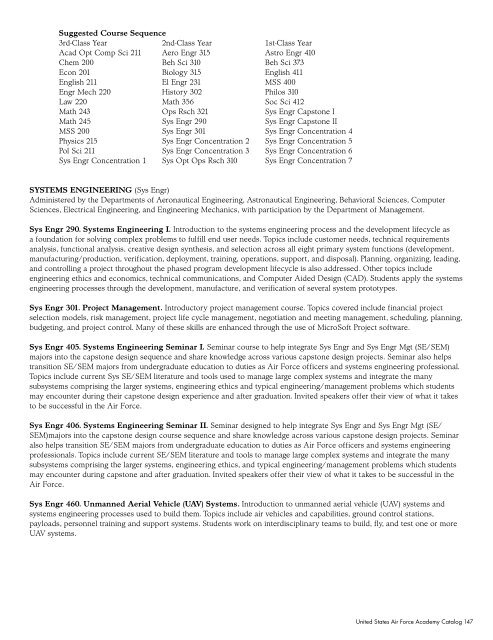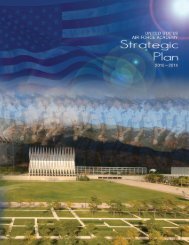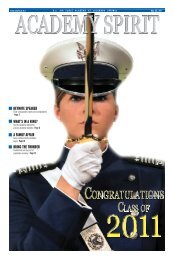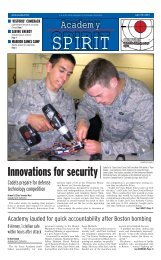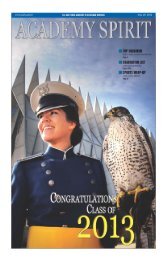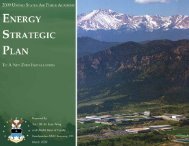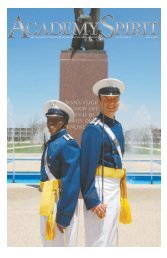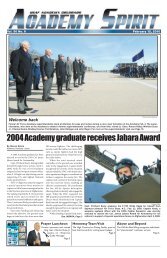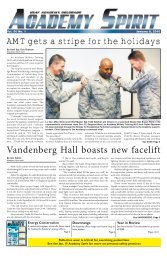2008-2009 Catalog - United States Air Force Academy
2008-2009 Catalog - United States Air Force Academy
2008-2009 Catalog - United States Air Force Academy
Create successful ePaper yourself
Turn your PDF publications into a flip-book with our unique Google optimized e-Paper software.
Suggested Course Sequence<br />
3rd-Class Year 2nd-Class Year 1st-Class Year<br />
Acad Opt Comp Sci 211 Aero Engr 315 Astro Engr 410<br />
Chem 200 Beh Sci 310 Beh Sci 373<br />
Econ 201 Biology 315 English 411<br />
English 211 El Engr 231 MSS 400<br />
Engr Mech 220 History 302 Philos 310<br />
Law 220 Math 356 Soc Sci 412<br />
Math 243 Ops Rsch 321 Sys Engr Capstone I<br />
Math 245 Sys Engr 290 Sys Engr Capstone II<br />
MSS 200 Sys Engr 301 Sys Engr Concentration 4<br />
Physics 215 Sys Engr Concentration 2 Sys Engr Concentration 5<br />
Pol Sci 211 Sys Engr Concentration 3 Sys Engr Concentration 6<br />
Sys Engr Concentration 1 Sys Opt Ops Rsch 310 Sys Engr Concentration 7<br />
SYSTEMS ENGINEERING (Sys Engr)<br />
Administered by the Departments of Aeronautical Engineering, Astronautical Engineering, Behavioral Sciences, Computer<br />
Sciences, Electrical Engineering, and Engineering Mechanics, with participation by the Department of Management.<br />
Sys Engr 290. Systems Engineering I. Introduction to the systems engineering process and the development lifecycle as<br />
a foundation for solving complex problems to fulfill end user needs. Topics include customer needs, technical requirements<br />
analysis, functional analysis, creative design synthesis, and selection across all eight primary system functions (development,<br />
manufacturing/production, verification, deployment, training, operations, support, and disposal). Planning, organizing, leading,<br />
and controlling a project throughout the phased program development lifecycle is also addressed. Other topics include<br />
engineering ethics and economics, technical communications, and Computer Aided Design (CAD). Students apply the systems<br />
engineering processes through the development, manufacture, and verification of several system prototypes.<br />
Sys Engr 301. Project Management. Introductory project management course. Topics covered include financial project<br />
selection models, risk management, project life cycle management, negotiation and meeting management, scheduling, planning,<br />
budgeting, and project control. Many of these skills are enhanced through the use of MicroSoft Project software.<br />
Sys Engr 405. Systems Engineering Seminar I. Seminar course to help integrate Sys Engr and Sys Engr Mgt (SE/SEM)<br />
majors into the capstone design sequence and share knowledge across various capstone design projects. Seminar also helps<br />
transition SE/SEM majors from undergraduate education to duties as <strong>Air</strong> <strong>Force</strong> officers and systems engineering professional.<br />
Topics include current Sys SE/SEM literature and tools used to manage large complex systems and integrate the many<br />
subsystems comprising the larger systems, engineering ethics and typical engineering/management problems which students<br />
may encounter during their capstone design experience and after graduation. Invited speakers offer their view of what it takes<br />
to be successful in the <strong>Air</strong> <strong>Force</strong>.<br />
Sys Engr 406. Systems Engineering Seminar II. Seminar designed to help integrate Sys Engr and Sys Engr Mgt (SE/<br />
SEM)majors into the capstone design course sequence and share knowledge across various capstone design projects. Seminar<br />
also helps transition SE/SEM majors from undergraduate education to duties as <strong>Air</strong> <strong>Force</strong> officers and systems engineering<br />
professionals. Topics include current SE/SEM literature and tools to manage large complex systems and integrate the many<br />
subsystems comprising the larger systems, engineering ethics, and typical engineering/management problems which students<br />
may encounter during capstone and after graduation. Invited speakers offer their view of what it takes to be successful in the<br />
<strong>Air</strong> <strong>Force</strong>.<br />
Sys Engr 460. Unmanned Aerial Vehicle (UAV) Systems. Introduction to unmanned aerial vehicle (UAV) systems and<br />
systems engineering processes used to build them. Topics include air vehicles and capabilities, ground control stations,<br />
payloads, personnel training and support systems. Students work on interdisciplinary teams to build, fly, and test one or more<br />
UAV systems.<br />
<strong>United</strong> <strong>States</strong> <strong>Air</strong> <strong>Force</strong> <strong>Academy</strong> <strong>Catalog</strong> 147


